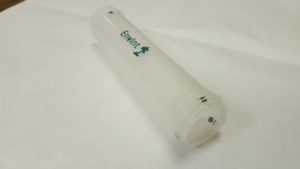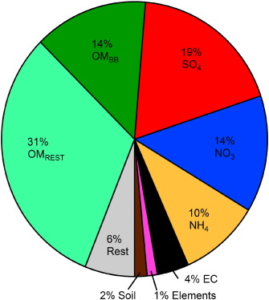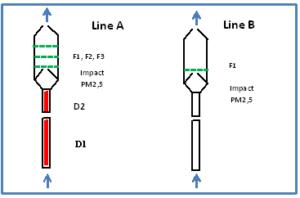reEvolution
Air Sampler
 EnvInt srl
EnvInt srl
Environmental International Consulting
________________________________________
ENVINT GAS08/16 Gas/Aerosol Manual Sampler
Presentation of the instrument, Dec 2017

ENVINT
Annular
Denuder
Preface
Monitoring of atmospheric pollution need the measurement of several parameters. Most of them are related to gas phase species for which limits and standard have been set by most national and supra-national legislations. Those species are usually monitored through proper automatic analysers that ensure a continuous evaluation of their concentrations. Although the developments in environmental instrumentation allow automated monitoring of several pollutants, for many other species it is necessary to adopt manual methods. They are usually based on a sampling step in which pollutants are sampled from the air, followed by an analytical step to be carried out in laboratory where the pollutants are measured. Manual methods are time consuming and expensive in terms of human resources, while automatic devices are expensive in terms of investment and maintenance.
Since, as said before automatic instruments are expensive in terms of investment and maintenance, their use is restricted to just a few “reference monitoring stations” or “superstations” which are characterised by an extensive use of up-to-date devices. Such stations are limited in number, thus the space distribution of several environmental parameters is very poor. This means that manual methods, whenever possible, are to be used if the said parameters need to be evaluated in several locations.
This is the case of ionic composition of particulate matter. This data is very important because ions are important components in fine particulate matter (PM10 and PM2,5). Soluble ions includes sulphates, nitrates, ammonium ions which actively participate to the formation of secondary particulate from primary compounds (Sulphur Dioxide, Nitrogen Oxides and Ammonia). As a consequence, an accurate monitoring of soluble ions may be very useful in understanding the sources of particulate matter and thus important for planning control strategies. From a quantitative point of view, soluble ions may account up to 60% of the total mass of particulate matter, as it shown, as an example, in the next figure.
Composition of PM2,5 at a rural background in Europe. Schartz J. et al., Atmos. Res. 176, 108 (2016)
Monitoring of soluble ions is also required by the current legislation in air pollution in Europe. In fact, Art.6 (Assessment criteria, Paragraph 5) requires that “measurements shall be made, at rural background locations away from significant sources of air pollution, for the purposes of providing, as a minimum, information on the total mass concentration and the chemical speciation concentrations of fine particulate matter (PM2,5)”. Annex IV is providing details on species to measured. According to the annex, measurement of PM2,5 must include at least the total mass concentration and concentrations of appropriate compounds to characterise its chemical composition. At least, the list of chemical species given below shall be included.
| Sulphate | Sodium | Ammonium | Calcium | Elemental Carbon |
| Nitrate | Potassium | Chloride | Magnesium | Organic Carbon |
According to Directive requirements, the measurements should be carried out in rural background locations. However, a generalisation to other locations, including urban sites, might certainly be useful in order to understand the nature and the sources of particulate matter.
In order to carry out such measurement, dedicated sampling lines should be used.
- Since gravimetric concentration of PM2,5 is necessary, a sampling line should collect particulate matter on which gravimetric measurements can be carried out. Since elemental and organic carbon concentration is also required, quartz filters can be used for such measurements.
- Cation measurements (Sodium, Potassium, Calcium, Magnesium) requires just a filter on which PM2,5 is sampled and then analysed by means of Ion Chromatography.
- Other soluble ions (Sulphates, Nitrates, Chlorides and Ammonium) require sampling through a filter. However, their measurement is affected by positive and negative sampling artefacts. Positive artefacts are related to the absorption of gases (SO, NOx, etc.) which may be absorbed on particulate matter giving soluble ions not contained in PM2.5. Negative artefacts are expected by evaporation of several ions (Nitrates, Ammonium) from the sampling filters. Ions released by the sampling filters are required to be collected on “back-up filters”.
Soluble ions then requires a sampling line which is composed by diffusion denuders for the collection of reactive gases in order to eliminate positive artefacts. The denuders are followed by an impactor for the selection of the PM2.5 or PM10 fractions. A first front filter is then collecting PM on which analysis of soluble ions is carried out and a series of backup filters used for the collection of gas species released by the first front filter, correcting for negative artefacts.
The Instrument
ENVINT GAS08/16 Gas/Aerosol sampler is a device specifically developed and intended for the selective sampling of gases and aerosol present in the atmospheric environment. Sampling step is completely automatic and does not need any kind of external intervention. In addition to requirements set in Art. 6 of the Directive, it can be used in air pollution monitoring, source apportionment and air pollution dispersion studies. It can sample reactive gases without any interference by particles by using annular denuders.
Basically, the instruments consists of a double independent sampling circuits operating with two sampling pumps for nominal flow rates ranging from 1 to 10 L/min. Each sampling circuit is controlling up to four sampling lines which are configured according to the scheme A and B outlined below.
- In Line A, the denuder D1 (Coated with an alkaline substance) removes acidic gases, while the denuder D2 (Coated with an acid substance) remove alkaline gas such as ammonia. Air, spoiled by reactive gases, passes through an impactor (PM10 or PM2,5) and then filtered in a first front filter F1 (Teflon filter). After the front filter, air passes through the back-up filters intended for the collection of evaporated acid species (F2) and alkaline species (F3).
- In Line B, the denuders are not coated and serve as fluido-dynamic coupling. After the impactor, air is filtered in a Quartz filter. This can be used for the gravimetric analysis as well as for the evaluation of Elemental and Organic carbon. Line B is consistent with the standard methods for the collection and gravimetric measurement of particulate matter.
GAS 08/16 can then operates as a normal 8 lines sampler or operates according to a random or sequential sampler over two types of sampling lines. Sampling line A and a sampling line B can be operated in parallel at the same time providing samples for:
- Reactive gas concentrations
- Gravimetric and EC/OC analysis
- Ionic composition of particulate matter
In details, GAS 08/16 may provide the following information
[NO3−]evolved =[NO3−]N (1)
[Cl−]evolved =[Cl−]N (2)
[NH4+]evolved =[NH4+]N+[NH4+]PA (3)
[NO3−]unevolved =[NO3−]T (4)
[Cl−]unevolved =[Cl−]T (5)
[NH4+]unevolved =[NH4+]T (6)
[NO3−]fine =[NO3−]unevolved+[NO3−]evolved (7)
[Cl−]fine =[Cl−]unevolved+[Cl−]evolved (8)
[NH4+]fine =[NH4+]unevolved+[NH4+]evolved (9)
[SO4-2]fine =[SO4-2]T (10)
[PM10 or PM2,5] Q (11)
[EC and OC] Q (12)
[NH3 gas] D2 (13)
[SO2, Acids gas] D1 (14)
where terms N, PA T and Q stand for the back up alkaline filter (Nylon filter), back up acid filter (phosphorous acid coated paper filter), Teflon filter, and Quartz filter respectively. The fine particulate SO4−2 is not volatile; therefore, its concentration is taken as that on the Teflon filter only.
It is worth stressing that the described sampling line is just related to the measurement of several species of significance for inorganic secondary pollution. However, the system can be made more simple and adapted for the measurement of selected species, For instance, by using one denuder and one Teflon filter, it is possible to measure simultaneously the concentration of sulphur dioxide in gas phase and of sulphates in particulate matter. Some example of additional applications is given below
| Configuration of sampling line | Measured species | |
| Denuders | Filter Pack | |
| 1 Alkaline coating (Na2CO3) | 1 Nylon | SO2(gas); SO4 (part) |
| 1 Acid Coating (Citric or Phsphorous Acid) | 1 H3PO3 paper impregnated | NH3(gas); NH4+ (Part) |
| 1 Alkaline Carbon | 1 Nylon | NO2(Gas)+NO3.(part) |
| 1 Nacl | 1 Nylon | HNO3(gas)+NO3-(part) |
| 1 NaCl + 1 Akaline Coating | 1Nyllon | HNO3(gas); HNO2 (gas); NO3.(Part) |
Technical Specifications
| Type of sampler | Dual pump with denuder/filter pack sampling system |
| Number of sampling lines | 8 |
| Channel activation | Electro-valves |
Available sampling packs (see description) |
1) Denuders and filter pack with PM2,5 impactor 2) Single filter with PM2.5 Impactor |
| Filters | 37mm diameter quartz, Teflon, paper |
| No of filter packs | – 4 filter packs type A – 4 filter pack type B – 8 filter packs of either type 1 or type 2 |
| Impactors | PM2,5 or PM10 (other cut sizes on request) |
| Other sampling devices | Cartridges for VOC, impregnated filters, stc. |
| Sampling flow rate | 1 to 10 L/min programmable by user |
| Accuracy and precision | 1% |
| Volume correction | Correction at standard T and P on request |
| On Board sensors | Temperature, Relative Humidity, Atmospheric Pressure, Flow rate, Pump current (related to back-pressure) |
| External sensors | Unlimited through I2C interface |
| Digital input | Up to 3 (dry contacts connection) |
| Programming | Tablet with Android OS (included) |
| Electronic Connections | Local Wi-Fi |
| Data output | Digital (pen drive) or output on tablet |
| Type of sampling | – Single or twin sampling operation – Sequential sampling according to programmed timing – Sampling on Events by Digital inputs |
| Input voltage | 12, Current 1A by external supply |
| Power fail | Automatic restart |
| Size | LxDxH cm 60x25x90 |
| Weight | 10 Kg (complete with filter holders) |
| Operating Temperature | -10 to +35°C |
| Operating external relative humidity | 100% |
Applications
- Evaluation of chemical composition of particulate matter
- Mass concentration measurements of PM2,5 and PM10.
- Sequential or conditional sampling to external inputs.
- Simultaneous measurement of PM fractions and gas/aerosol concentration by sampling time distribution.
- Urban and traffic pollution
- Indoor pollution
- Industrial pollution
- Pollution in working sites
- Environmental impact assessment
- Air pollution alerts ad emergencies
- Source apportionment studies


